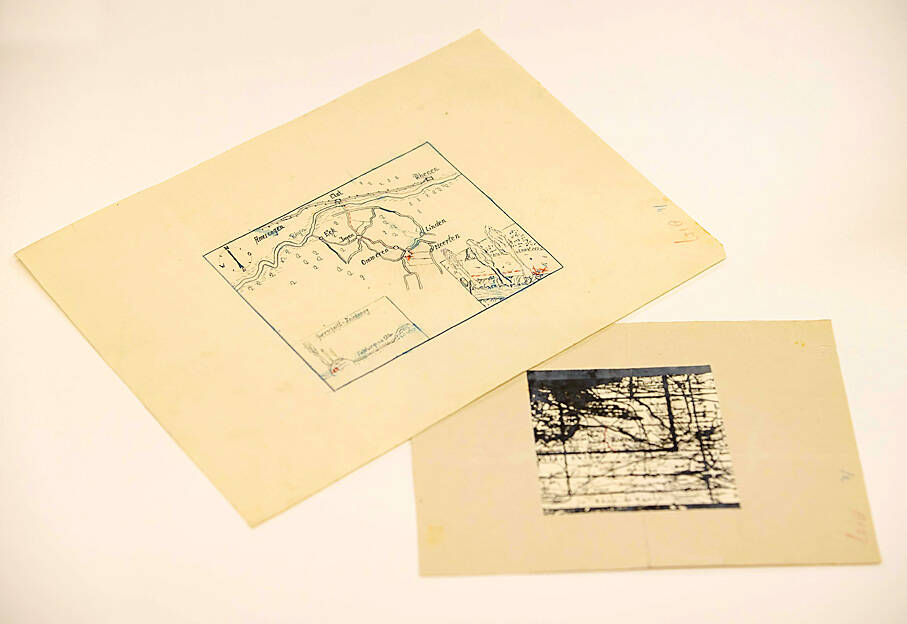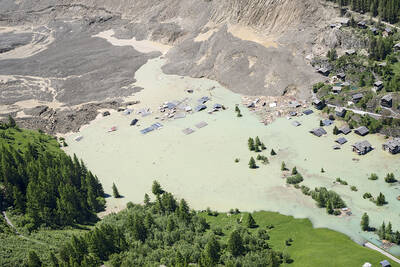As the Nazis fled occupied Europe in the final days of World War II, four German soldiers buried a hoard of gold coins and jewels in the middle of nowhere in the Dutch countryside. Nearly 80 years later, hopes of finding the buried loot have been raised after the Dutch National Archives released a trove of documents — and a map to the treasure where X marks the spot.
The treasure — four ammunition cases laden with coins, watches, jewelry, diamonds and other gemstones — is thought to have been worth at least 2 million or 3 million Dutch guilder in 1945, the equivalent of about US$19.2 million in today’s money.
“A lot of researchers, journalists and amateur archeologists are really interested and excited,” said Annet Waalkens, an adviser at the National Archives, which last week released more than 1,300 historical documents.

Photo: EPA-EFE
Whether any would-be treasure hunter would be able to find the cases is another matter. Among the cache of World War II papers was a 7cm-thick file that recounted the fruitless efforts of the Dutch state to find the looted Nazi treasure after the war.
Researchers believe the treasure was buried in April 1945, when the Allies were on the brink of liberating Arnhem in the eastern Netherlands. German soldiers were fleeing.
“They decide to bury the treasure, because it’s just getting a bit too hot under their feet and they’re getting scared,” Waalkens told the Observer.
The precious cargo was buried in the roots of a poplar tree, 70cm to 80cm deep, just outside the village of Ommeren, about 40km from Arnhem.
The riches might have vanished from the historical record forever were it not for a chatty German soldier, Helmut S, who was not one of the original looters, but took part in the burial.
The National Archives are withholding his full name, as Helmut S, born in 1925, might still be alive, although no one has been able to trace him.
Of the three other soldiers, two did not survive the war and the other simply vanished.
However, Helmut S stayed on the radar.
“He was a bit loose-lipped back in Berlin,” Waalkens said.
He soon came to the attention of Dutch authorities in the occupied German city. They passed the information on to the Beheersinstituut, the Dutch Institute of Asset and Property Management, a body responsible for managing the wealth of people who had disappeared in World War II, including deported Jews, Dutch spies and German citizens who lived in the Netherlands.
Helmut S said that the hoard was discovered when an Arnhem branch of the Rotterdamsche Bank was bombed in August 1944.
A safe was smashed, leaving jewels, coins and other riches scattered in the street, and his comrades pocketed what they could see, later hiding the loot in zinc ammunition boxes, he said.
In 1946 and 1947 the Beheersinstitut carried out three searches. The first failed because the ground was frozen. The second, aided by primitive metal detectors of the time, yielded nothing.
For the third attempt they summoned Helmut S back from Germany to help, but despite his eyewitness knowledge and the map he had provided, the dig was fruitless.
Archivists are not certain who made the map, but believe it was done by one of the German soldiers. After Helmut S handed it over, the map went into the file of the Beheersinstituut, with the proviso it would not be released for many years to protect the financial interests of the property owners.
Dutch officials toyed with several theories. Perhaps the treasure had been dug up by a local who witnessed the burial or by the mystery surviving German soldier.
Others suspected the Americans. During the third dig, Beheersinstituut staff encountered two US officers and noticed that the soil in the area had been disturbed.
“And they actually go to them and they say: ‘Well, we don’t know what you’re doing, but please mind your business and this is our affair,’” Waalkens said.
Joost Rosendaal, an assistant professor in history at Radboud University, said that looting was common on both sides.
In October 1944 at least five banks in Arnhem were looted by German soldiers. After the liberation in April 1945, another was robbed by troops in British uniforms, a group that included one Dutchman serving in the South Wales Borderers.
The historian believes Helmut S got some of the facts wrong.
Helmut’s version that his comrades stumbled across the jewels in the street after a bank was hit in August 1944 “can’t be true,” because Arnhem was not bombed in that month, Rosendaal said.
It was not until September that the Allies attempted to take Arnhem, in the disastrous Operation Market Garden. This reckless gamble by British Field Marshal Bernard Montgomery to break through to Germany cost many lives and was later dramatized in the 1977 film A Bridge Too Far.
Rosendaal said it is likely the other soldiers stole the jewels in November 1944 when German forces set fire to Arnhem’s Rotterdamsche Bank, with the blaze intended to “hide the robbing of the bank.”
The historian doubts the treasure will ever be found. The area around Ommeren was heavily bombed on the night of April 24, 1945, by the Royal Air Force.
Rosendaal said he suspects the hiding place was “destroyed by this bombardment,” allowing the treasure to be discovered by locals or Allied troops, or it was taken to another location by the Germans.
The Dutch archive team is more hopeful now the map is online and available to view in person at the Hague, alongside other papers from its 142km-long collection.
“I really hope that it is still there, and that when it’s dug out perhaps we could trace some of the rightful owners,” Waalkens said.

Four people jailed in the landmark Hong Kong national security trial of "47 democrats" accused of conspiracy to commit subversion were freed today after more than four years behind bars, the second group to be released in a month. Among those freed was long-time political and LGBTQ activist Jimmy Sham (岑子杰), who also led one of Hong Kong’s largest pro-democracy groups, the Civil Human Rights Front, which disbanded in 2021. "Let me spend some time with my family," Sham said after arriving at his home in the Kowloon district of Jordan. "I don’t know how to plan ahead because, to me, it feels

The collapse of the Swiss Birch glacier serves as a chilling warning of the escalating dangers faced by communities worldwide living under the shadow of fragile ice, particularly in Asia, experts said. Footage of the collapse on Wednesday showed a huge cloud of ice and rubble hurtling down the mountainside into the hamlet of Blatten. Swiss Development Cooperation disaster risk reduction adviser Ali Neumann said that while the role of climate change in the case of Blatten “still needs to be investigated,” the wider impacts were clear on the cryosphere — the part of the world covered by frozen water. “Climate change and

Poland is set to hold a presidential runoff election today between two candidates offering starkly different visions for the country’s future. The winner would succeed Polish President Andrzej Duda, a conservative who is finishing his second and final term. The outcome would determine whether Poland embraces a nationalist populist trajectory or pivots more fully toward liberal, pro-European policies. An exit poll by Ipsos would be released when polls close today at 9pm local time, with a margin of error of plus or minus 2 percentage points. Final results are expected tomorrow. Whoever wins can be expected to either help or hinder the

DENIAL: Musk said that the ‘New York Times was lying their ass off,’ after it reported he used so much drugs that he developed bladder problems Elon Musk on Saturday denied a report that he used ketamine and other drugs extensively last year on the US presidential campaign trail. The New York Times on Friday reported that the billionaire adviser to US President Donald Trump used so much ketamine, a powerful anesthetic, that he developed bladder problems. The newspaper said the world’s richest person also took ecstasy and mushrooms, and traveled with a pill box last year, adding that it was not known whether Musk also took drugs while heading the so-called US Department of Government Efficiency (DOGE) after Trump took power in January. In a